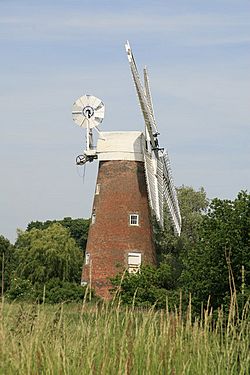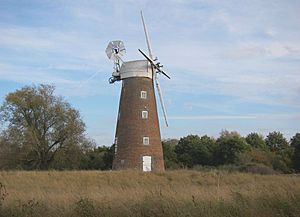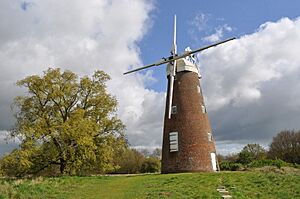Billingford Windmill facts for kids
Quick facts for kids Billingford Windmill |
|
|---|---|

Billingford Mill
|
|
| Origin | |
| Mill name | Billingford Mill |
| Grid reference | TM 167 786 |
| Coordinates | 52°21′44″N 1°10′51″E / 52.3622°N 1.1808°E |
| Operator(s) | Norfolk Windmills Trust |
| Year built | 1859 |
| Information | |
| Purpose | Corn mill |
| Type | Tower mill |
| Storeys | Five storeys |
| No. of sails | Four sails |
| Type of sails | Double Patent sails |
| Windshaft | cast iron |
| Winding | Fantail |
| Fantail blades | Six blades |
| Auxiliary power | Steam engine, later replaced by an oil engine |
| No. of pairs of millstones | Two pairs, a third pair driven by engine |
| Size of millstones | Engine driven stones 3 feet (910 mm) diameter |
| Other information | Last windmill to work by wind commercially in Norfolk |
Billingford Windmill is a special old building in Billingford, near Diss, Norfolk, England. It's a tall brick tower mill that has been saved and fixed up so it can work again. As of 2009, the windmill was being repaired, and new sails were being built for it.
Contents
History of Billingford Windmill
Early Days and a New Mill
A windmill was first shown on a map of Norfolk in 1797. This was an older type of mill called a post mill. It had two pairs of millstones to grind grain. Sadly, this first mill was blown down in a big storm on September 22, 1859.
A brand new tower mill was built to replace it for William Chaplyn. It cost £1,300, which was a lot of money back then! The new mill was finished by March 1860.
Changes and Challenges
Over the years, the mill had different owners and workers. By 1881, the mill could also be powered by a steam engine. This meant it could still grind grain even when there wasn't enough wind. Later, by 1916, an oil engine was put in to help.
In 1924, George Daines bought the mill. His son, Arthur, joined the business in 1933. Arthur worked at the mill until he joined the Royal Navy during the Second World War.
The Last Working Windmill
When Arthur Daines came back in 1945, the mill needed a lot of repairs. It cost over £300 to get it working again. The mill was then used with only two sails instead of four.
Arthur Daines continued to use the wind to power the mill until 1956. This made Billingford Windmill the very last windmill in Norfolk to work commercially using only wind power! Milling continued with the engine until 1959.
Saving the Windmill
The mill was bought by Victor Valiant, who wanted to save it. In 1962, work began to restore the mill. Many groups helped raise money for the repairs, including the Society for the Protection of Ancient Buildings and the Norfolk County Council. The restoration cost £3,939.
On September 24, 1965, Mr. Valiant gave the mill to the Norfolk Windmills Trust. This trust helps look after windmills in Norfolk.
Recent Repairs and Use
In 1976, a strong storm damaged the mill's fantail, which helps the mill turn into the wind. It was quickly replaced. Later, in 1977, a new strong steel part was fitted to hold the sails.
In 1998, the Norfolk Windmills Trust got the mill fully working again. In 2002, Linda Joslin became the first woman miller at Billingford. She and volunteers used the mill to grind organic wheat. The first "Billingford Loaf" in 50 years was made that year!
After some time, the mill was not used for a few years and started to wear down. On June 11, 2009, the sails had to be taken off because they were rotten and needed to be replaced. New sails were finally put in place in September 2020, so the windmill can continue to be a special part of Norfolk's history.
How Billingford Windmill Works
Billingford Windmill is a five-storey tower mill. It has a special boat-shaped top that turns with a fantail to face the wind. The tower is about 36 feet (11 meters) tall.
The mill has four double Patent sails. These sails are carried on a strong cast-iron windshaft. Inside, a large wheel called the brake wheel has a special mark from 1860. The main shaft, called the upright shaft, is made of cast iron.
The mill has two pairs of millstones that grind grain from above. There's also a third pair of millstones on the ground floor. These can be powered by an engine when there's no wind.
Visiting Billingford Mill
Billingford Mill is open to the public on certain Sundays and Bank Holidays. You can also arrange a visit by contacting the Norfolk Windmills Trust. It's a great chance to see a working windmill up close!
Culture and Media
James Henry Govier (1910–1974) was an artist who lived nearby. He painted many pictures of Billingford Windmill.



